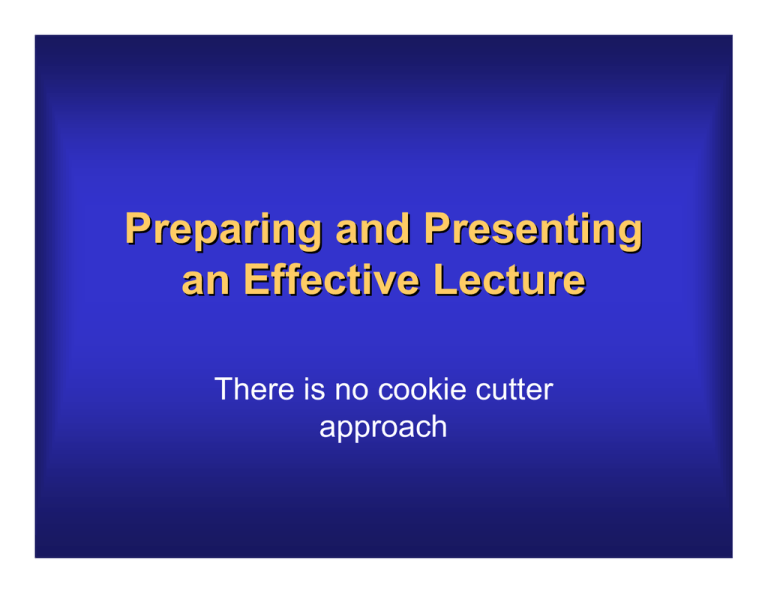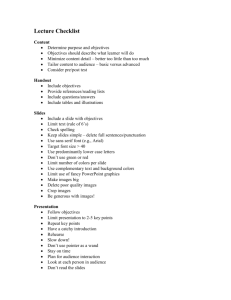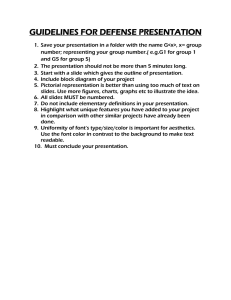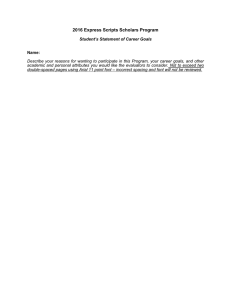Preparing and Presenting an Effective Lecture
advertisement

Preparing and Presenting an Effective Lecture There is no cookie cutter approach Know the Material • Demonstrate confidence • Review the material • Practice your lecture • Revise if necessary • Be passionate Know the Room • Learn the lecture room • Arrive early • Walk around the speaking area • Practice with the AV equipment Detach Yourself From Your Own Interests • Consider the needs of the students • Don’t teach material that’s only of interest to you • Theory and science not applicable to patient care are okay, but … • Put yourself in the position of the student • Know the audience Choose Your Material Carefully • Limit amount of material – Include all necessary material – If excessive, little is learned • Limit complexity of material – Avoid – Simplify – Explain Target Audience • Any student that wants to learn • Donald Seldin: “Teach to the least intelligent student in the class. Anyone can teach a genius. What separates good teachers from great teachers is the ability to teach students at the lower end of the class.” Engage the Students • Make the students partners with you regarding the subject • Give them a reason to care • Explain to the students why they should be interested in the material Engage the Students • • • • • Make eye contact Use your hands Move Face the audience Use the laser pointer minimally Engage the Students • Humor – Spontaneous – Relevant – Balance entertainment with information – Medical cartoons available on internet • Enthusiasm – Be interested in material – Be interested in teaching Engage the Students • Pay attention to the audience • Modify your speaking style and actions based on audience response • State rhetorical questions from the student’s point of view Attitude • Relax • Exercise • Mentally walk your way through the experience step by step • The audience wants you to succeed • Don’t apologize • Turn nervous energy into enthusiasm • Gain experience and training Voice Tips • • • • Adequate speaking level Microphone Articulate every word Don’t speak with too many words in one breath • Rest your voice • Keep water available Voice Tips • Avoid alcohol and caffeine before speaking • Be rested • Don’t smoke • Avoid eating or drinking just prior to lecture • Treat or avoid heartburn Slides • Slides can be deadly – Students need to listen to you and think – Too many words → too much writing – Reflex pathway • Slides are okay if best for presenting information – Not just for your convenience – Displaying images – Put them in the syllabus or handout Slides • Don’t include material you won’t discuss – Distracting – Don’t use old slides • “I apologize for this slide.” – Unacceptable expression – Don’t apologize. FIX IT! Slides • A font size of 32 is ideal • 28 font is also easy to see • Font size 24 is acceptable • A font size of 20 may be difficult to see from the back of a large room • Forget about size 16 font or lower, unless it is a disclaimer that you don’t want the audience to read • The authors of this presentation are not responsible for any disasters disasters that may occur during your future lectures Slides • Keep the background simple • Use just one or two colors for fonts – Avoid dark colors – Use bright colors • • • • Use light font on a darker background Color blind students 12 lines per slide, if possible List the main point on each bullet, then expand on it verbally • Minimize movement and audio if it distracts from your message Examples of Bad Slides We’ve all used these! Blackboard • Advantages of the “blackboard” – You can’t write faster than the students can – Allow them to relax and listen to you – The time and effort it takes to write on the board causes you to limit what you write • The material eliminated is generally not missed by anyone Above All… Be Yourself


![To create the proper [ ] symbol so that the 26 is](http://s2.studylib.net/store/data/015124009_1-471f69fb234e90a366098dc66351a189-300x300.png)

